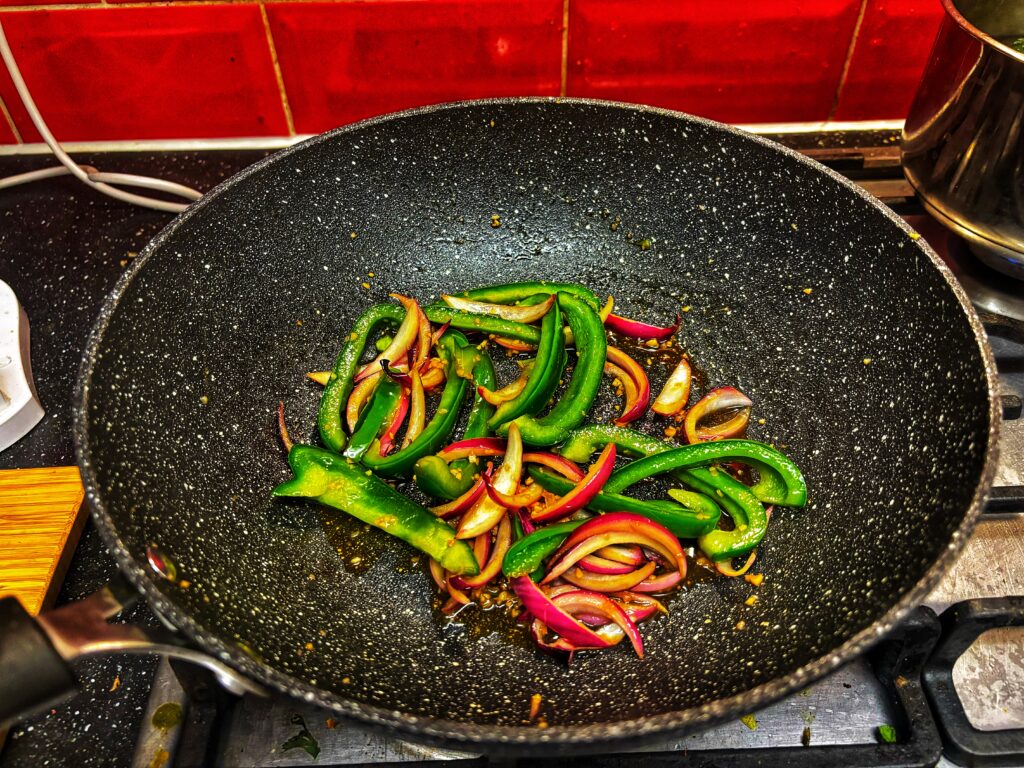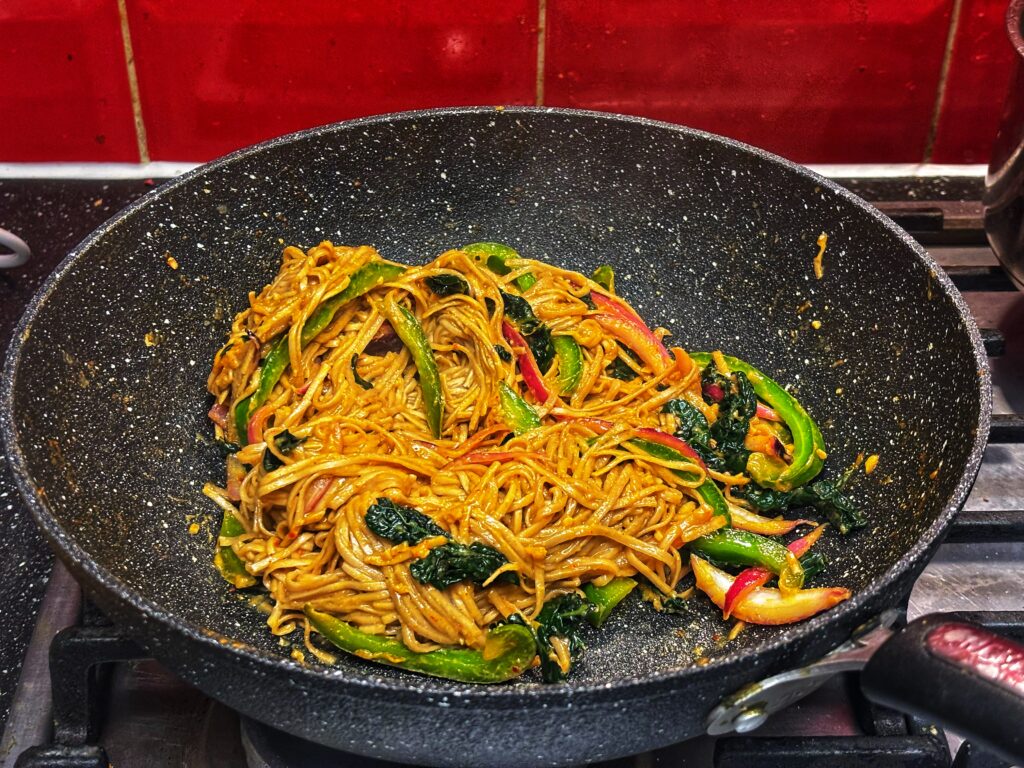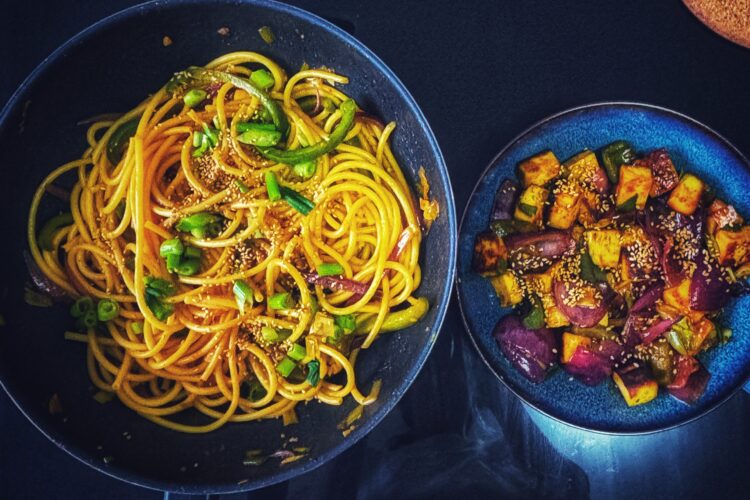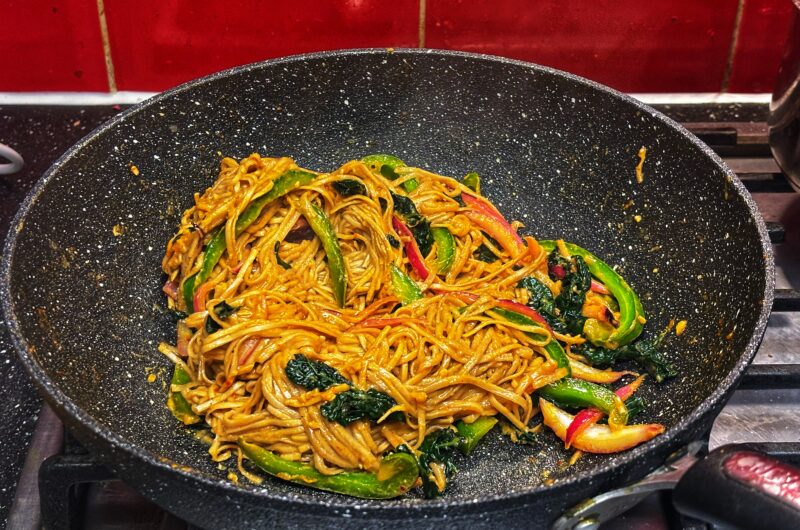Dive into this comforting Indo-Chinese classic and enjoy a healthy fun-filled vegan meal with your family
I recently shared a recipe for Paneer Chilli, an Indo-Chinese favorite. If you had a childhood like mine, you probably remember that paneer chilli was always accompanied with the irresistible aroma of spicy, savory, and perfectly nostalgic Hakka noodles. But for me, my earliest and most cherished memory of enjoying Hakka noodles goes back to a summer vacation when I was seven.
One evening, after a long summer day of games and fun, my cousins and I were huddled around a table, eagerly digging into a feast of steaming hot noodles, crispy deep-fried Manchurian, and fiery Gobi 65 from a tiny neighborhood Chinese takeaway. We loved it so much and wanted it again. So, the next day, my aunt decided to make us a homemade, healthier version. That dish became a family classic, and our family has been making and adapting this recipe ever since.
On a different note, have you ever wondered why it’s called Hakka noodles?
The Hakka people, a subgroup of the Han Chinese from Southern China, arrived in India over 200 years ago. Though fewer in number than the Cantonese settlers, they made a lasting impact on Indian cuisine—especially in West Bengal, where their influence first took root. Known for their resilience and adaptability, they modified their traditional dishes using local ingredients, shaping what we now recognize as Indo-Chinese food. Despite facing persecution in the 1960s, many Hakka Chinese families persevered, building thriving food businesses and leaving behind an enduring culinary legacy. Today, Kolkata’s Tiretta Bazaar (China Town) is where people can still see this history today.
If you’re curious about the intertwined histories of Indians and the Chinese diaspora, I highly recommend ‘Smoke & Ashes’ by Amitav Ghosh—a fascinating deep dive into this often-overlooked connection.
So, what makes this Hakka noodles special?
Unlike the more general term Chow Mein, which refers to Chinese-style noodle dishes, Hakka noodles is a distinct Indo-Chinese creation. People love it for its luscious wok-tossed noodles, crunchy fresh vegetables, umami-rich soy sauce, and a fiery chili kick. Another popular variation is Chili Garlic Noodles, which leans heavier on garlicky heat, while Hakka noodles maintains a balanced savory profile.
Just like the Hakka people themselves, this dish is versatile, adaptable, and effortlessly blends into any menu. It’s a classic street-food favorite—fast, comforting, and packed with flavor. However, my version is a little lighter and healthier. I use minimal oil, and unlike many restaurant versions, there are no artificial colors, Ajinomoto (MSG), or unnecessary additives; ingredients that were once considered essential flavor enhancers in Chinese street food but often deemed unhealthy.
I love buying my soy sauce and rice vinegar from the Lee Kum Kee brand. For my noodles, instead of resorting to the traditonal all-purpose flour noodles used in Indo-Chinese cooking, I love using Lucky Boat Chinese noodles.
Hakka Noodles: Diatery Restrictions & Modifications
Best of all? Hakka noodles is naturally vegan and can be made gluten-free.
My favourite gluten free alternative is the naturally gluten-free, Korean vermicelli rice noodles or the Korean Glass Noodles, making it a perfect dish for family meals, parties, or a quick, satisfying weeknight dinner.
So, let’s get cooking!
Sauteeing the vegetables and spices
- In a large pan, add 2 tbsp of oil. Once the oil heats up, add the ginger, garlic and slit chilli.
- Once the the ginger, garlic and chilli turn golden and aromatic, add the sliced onions.
- As the onions partially soften, add the sliced bell peppers and carrots. Turn the flame up to high and toss the veggies till they coat in oil.
- Turn of the flame and set aside.

Preparing the noodles
- Boil 1.5 liter water in a large pan. Once the water comes to a boil, add salt to the water.
- Add the noodles to the water.
- Cook the noodles as per the instructions on the package.
- Drain the water and set the noodles aside. Douse in cold water to pause the cooking
Putting the noodles together
- Add soy sauce, chilli sauce, pepper and tomato ketchup to the pan with the vegetables. Toss well to coat the spices and veggies with the sauces.
- Add the cooked noodles and combine everything well. Turn off the flame.
- Finally, add the vinegar and bean sprouts. Combine everything well.
- Garnish with the sping onion greens.

Serving Suggestions
This hakka noodles is great on its own. However, you can amp it up further to make an Indo-Chinese feast:
- Serve with Paneer Chili and crispy Gobi Manchurian.
- Pair it with dark rum or a lemonade for a casual Indian dining experience.
Chinese, the Indian way: Hakka Noodles
Course: MainCuisine: Indo-ChineseDifficulty: Easy2
servings15
minutes15
minutes420
kcalIngredients
- For the noodles
2 packets wheat noodles (or a gluten free option like rice vermicelli noodles)
1.5 liter water
4 tsp salt
- For the Hakka spice
2 tbsp oil (I prefer sesame oil but in the absence, any other neutral oil would work)
4 cloves garlic, thinly sliced
1 chilli, slit
2 tbsp spring onion, chopped
½ onion, sliced into thin long juliennes
½ bell pepper, sliced into thin long juliennes
1 carrot sliced
2 tbsp bean sprouts
2 tbsp chilli sauce
2 tbsp light soy sauce
2 tbsp tomato ketchup
2 tbsp white / rice vinegar (I prefer rice vinegar)
½ tsp pepper powder
Salt, to taste
Directions
- Sauteeing the vegetables and spices
- In a large pan, add 2 tbsp of oil. Once the oil heats up, add the ginger, garlic and slit chilli.
- Once the the ginger, garlic and chilli turn golden and aromatic, add the sliced onions.
- As the onions partially soften, add the sliced bell peppers and carrots. Turn the flame up to high and toss the veggies till they coat in oil.
- Turn of the flame and set aside.
- Preparing the noodles
- Boil 1.5 liter water in a large pan. Once the water comes to a boil, add salt to the water.
- Add the noodles to the water.
- Cook the noodles as per the instructions on the package.
- Drain the water and set the noodles aside. Douse in cold water to pause the cooking.
- Putting the noodles together
- Add soy sauce, chilli sauce, pepper and tomato ketchup to the pan with the vegetables. Toss well to coat the spices and veggies with the sauces.
- Add the cooked noodles and combine everything well. Turn off the flame.
- Finally, add the vinegar and bean sprouts. Combine everything well.
- Garnish with the sping onion greens.
Notes
- If you are serving noodles as a single dish, you can add pan-fried paneer or tofu to amp up the protein content and the taste.
- While the noodles aren’t the best for storing, you can reduce the time further by chopping the vegetables in advance or using chopped and frozen or pre-chopped veggies.
Serving Suggestions
Hakka noodles pair beautifully with Paneer Chilli or Vegetable Manchurian for a complete Indo-Chinese feast. Enjoy it fresh at home or pack it for lunch—just store it in an airtight container to keep the flavors intact.
Final Thoughts
A dish that’s as comforting as it is versatile—Hakka noodles is a celebration of flavors, history, and the joy of good food shared with loved ones. Let me know in the comments if you do make hakka noodles and be sure to share a nostalgic food from your childhood.



[…] Pair the paneer chilli with some steaming hot Hakka Noodles. […]